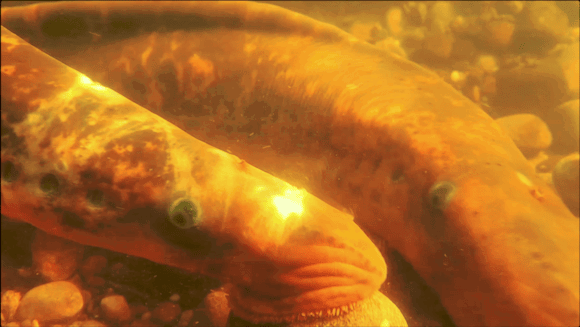Biodiversity boost for the River Dee after Erbistock Weir removal

The EU-funded LIFE Dee River project, led by Natural Resources Wales, is celebrating a remarkable success story for river restoration and biodiversity on the River Dee.
Following the removal of Erbistock weir last summer, fisheries experts have discovered 25 sea lamprey redds (nests) upstream of the former barrier - a clear and tangible sign that environmental interventions on the River Dee are gradually transforming the ecosystem for the better.
Earlier this month, the project team captured drone footage highlighting one of these redds just 40 metres downstream of Manley Hall gauging weir.
This confirms the removal of Erbistock weir has opened up an additional 4 kilometres of critical habitat, enabling these incredible, prehistoric fish to return to spawning grounds long restricted by man-made obstacles.
Tracking by the LIFE Dee River team revealed that, previously, most lamprey could not pass the 3-metre-high, 70-metre-wide structure, failing to reach their spawning grounds upstream and jeopardising the long-term survival of this protected species. Similarly, many salmon were delayed or prevented from passing Erbistock weir, also threatening their survival.
The weir removal has ensured that passage for all fish species, not just sea lamprey, is now unhindered for the first time in nearly 200 years.
Joel Rees-Jones, LIFE Dee River Project Manager, commented:
“Seeing these redds above the Erbistock weir removal site is genuinely exciting. It clearly shows that by reconnecting habitats and removing barriers like Erbistock weir, we’re giving iconic species such as lamprey and Atlantic salmon a fighting chance to thrive and build healthy populations.
“This is a huge win for biodiversity on the Dee, and demonstrates that ambitious river restoration like this can deliver immediate, measurable benefits for wildlife and improve the health of these vital ecosystems.”
While the project is yielding significant results above the former weir site, the concentration of sea lamprey redds immediately below Manley Hall gauging weir highlights that this structure remains a significant bottleneck to further upstream migration.
Many fish are still forced to spawn just downstream of this structure, restricting their natural instinct to migrate further upstream to key spawning areas.
Joel added:
“While we’re thrilled by what we’ve achieved so far, our surveys confirm that Manley Hall is the next major hurdle. That’s why we’re already planning targeted works here for next year, aiming to improve passage and ensure the benefits of a free-flowing Dee are fully realised.”
Erbistock weir removal, completed in 2024, is part of a wider suite of measures by the LIFE Dee River project to restore the internationally important ‘River Dee and Llyn Tegid Special Area of Conservation’. This catchment hosts a rich array of protected species, including Atlantic salmon, lamprey, otters, bullhead, and freshwater pearl mussel.
The project is funded by the EU LIFE programme, Welsh Government, Environment Agency, Eryri National Park, Dŵr Cymru/Welsh Water, and the River Restoration Centre.
To find out more about the project, visit the project’s webpage, follow @LIFEAfonDyfrdwy on social media or email the team at lifedeeriver@cyfoethnaturiolcymru.gov.uk
